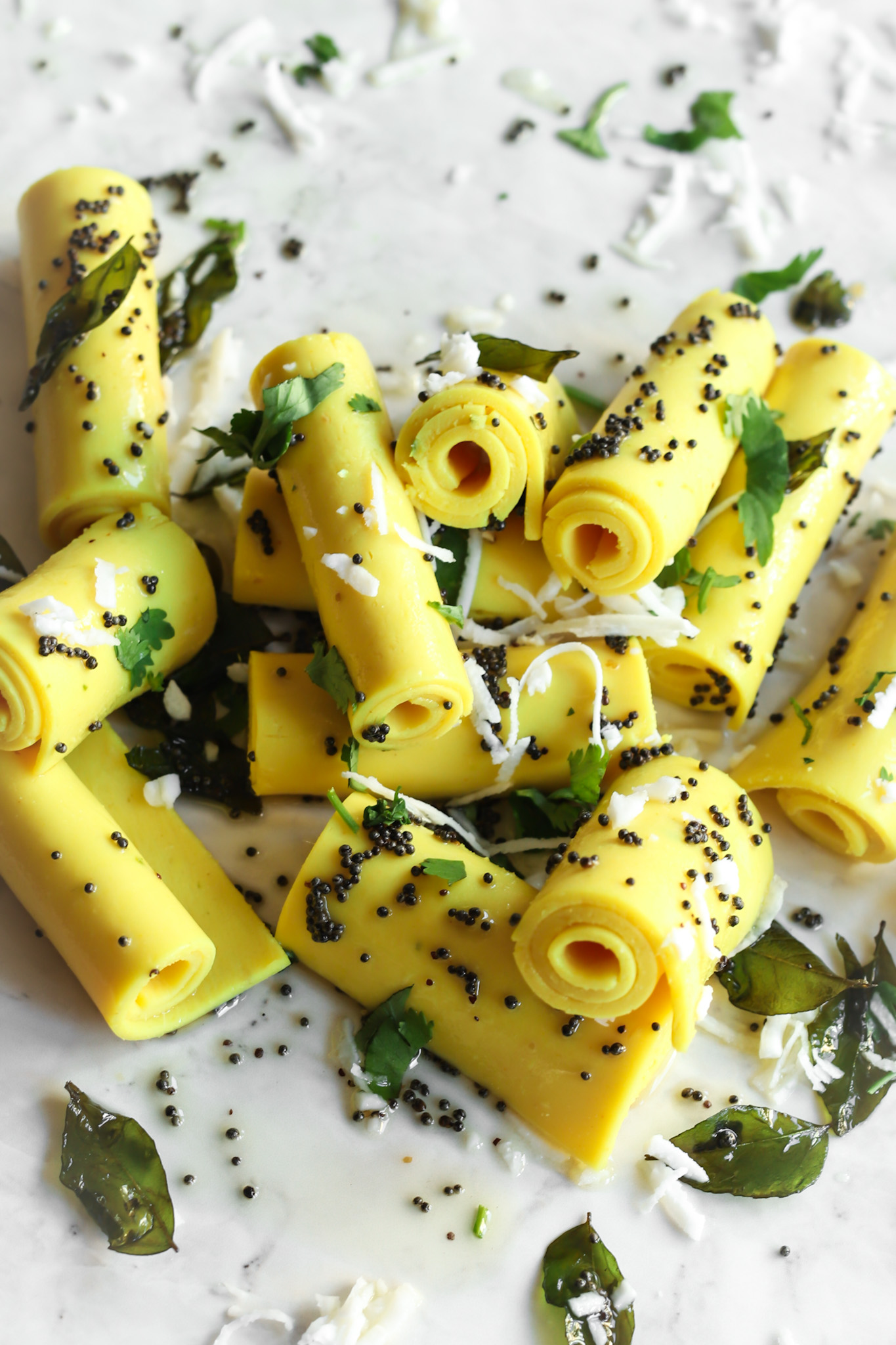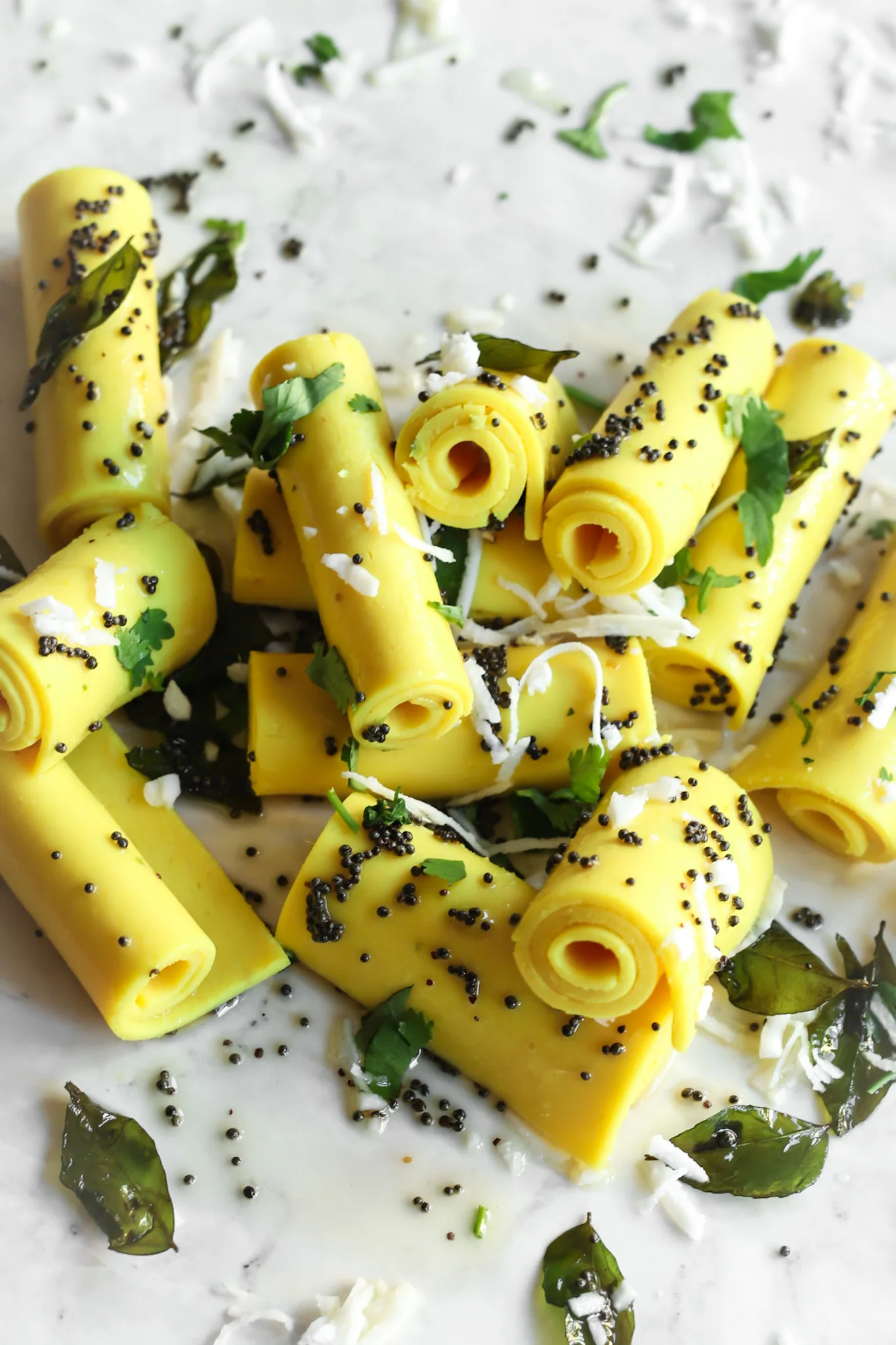Serve with chai for a tasty breakfast or snack. In Marathi they are known as Surali Vadi or Suralichi Wadi.
What is Khandvi?
Gujarati Khandvi (Patuli/Paturi) is a village-style rolled snack, resembling pasta in appearance but absolutely different in flavour and texture. It’s made with chickpea flour and yoghurt and is always served with a tempering of mustard seeds and curry leaves. Other additions to the tempering are chillies, sesame seeds and asafoetida. Fresh coriander leaves and shredded coconut are the most traditional garnishes. The sound and smell of the smoking oil hitting the smooth surface of the Khandvi is etched into the memory of almost all Gujaratis.
Why we love Gujarati Khandvi (Patuli/Paturi)
I love Khandvi it because it requires very few ingredients to make and it’s also one of those rare Gujarati naasto dishes (tea-time snacks) that isn’t fried. As much as I adore Bateta Vada (fried spicy potato balls), I know it’s not a treat I’ll scoff every day. These on the other hand, I’d go for Khandvi any time, any day. All you need are a few store cupboard ingredients, plain yoghurt and water. Simple.
What sets this recipe apart from the rest?
Learn to make delicious Gujarati Khandvi (Patuli/Paturi) and pick up some amazing grandma-style tips from me along the way. I’ll show you how to make a tasty batter that’s lump free and easy to spread.
What’s your magic ingredient?
Psst… Don’t tell anyone but I like to add a splash of coconut water to my Khandvi batter for another incredible dimension of flavour. However, this is a completely optional addition. Indeed, you can replace coconut water for the same measure of regular water without any problems.
How to serve Khandvi
Serve this comforting Khandvi either hot, cold, or at room temperature with your favourite chutney and/or masala chai.
What equipment do I need for making Gujarati Khandvi (Patuli/Paturi)?
Nothing too fancy. Here are some things I use:
Stick blender or jug blender (it’s not imperative to have either of these – you can always use a hand-held whisk).Large saucepan. Any will work but a non-stick pan is handy.Hand-held whisk. Metal or silicone. This recipe requires the batter to be beaten/whisked during the cooking process. Note: If using a non-stick pan, it’s best to use a silicone spatula to avoid scratching the pan’s non-stick coating. If you only have a metal whisk, use a stainless steel pan and be sure to whisk well to avoid any batter burning on the base of the pan.Aluminium foil or 3-4 large stainless steel thalis for spreading the batter. If you have neither, use a smooth, clean kitchen surface. These will all need to be greased very lightly before spreading.Cling film (plastic wrap). Not imperative but used in my method of spreading.Silicone spatula or flat-sided wooden spoon for spreading the cooked batter.Rolling pin (not imperative but used in my method of spreading).Small saucepan (any) or tadka pan for the tempering.
Tips for making perfect Gujarati Khandvi (Patuli/Paturi)
Here are some things to bear in mind when making Khandvi (grandma style) as well as some new school tips to roll your Khandvi thinly and evenly.
Use a blender for a smooth, cohesive Khandvi batter. Lumps aren’t wanted here. Wait, are lumps ever wanted anywhere?Cook the Khandvi batter in a non-stick pan, low and slow. It thickens pretty quickly so you want to give yourself time to get those pesky lumps out.Use a silicone spatula or whisk to stir when cooking the Khandvi batter.Pay close attention to the consistency of the batter. It’s ready when the batter no longer falls off the spatula when lifted and begins to set on the sides of the pan. Think peanut butter consistency. To check if the batter is ready to spread, you can spread a little bit over a steel plate or piece of foil, allow it to set for a few minutes and then see if it rolls up easily. If not, cook it a little longer.This one is super important… You need to work quickly! Khandvi batter doesn’t wait around. Once it reaches the right consistency, it must be spread very quickly. It helps to have your foil sheets ready on the work surface before you even start cooking the batter.A lot of recipes call for the surface of the foil or thali you’re spreading the batter on to be greased. Do this VERY lightly otherwise the batter is going to slide around and clump up like no man’s business. This will make it impossible to spread.To spread the khandvi, I use a silicone spatula. Once it’s spread as evenly as I can get it (and still hot), I cover it with a piece of cling film and then use a rolling pin to roll it as thin as I can get it, about 1-2mm.If you have one, use a pizza cutter to slice your set Khandvi – it’s so much easier and neater than trying to use a knife.This recipe is for traditional Gujarati-style Khandvi and uses plain yoghurt but here is a Vegan Khandvi recipe for my vegan friends.Finally, serve the Khandvi at room temperature simply by themselves, with masala chai or your favourite chutney.
Khandvi Troubleshooting
Pin it for later
If you like this, you’ll love my recipe for Gujarati Khaman (Dhokla)
Share this recipe

















